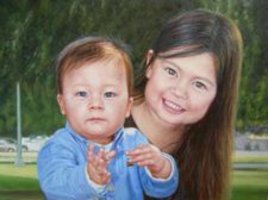At one point our guidelines for how to choose appropriate photos and  provide additional instructions includes a very funny and pointed comment: “Our artists are serious and talented painters, but they are not clairvoyant.” I find this reminder particularly helpful, because with a satisfaction guaranteed policy like we have, every customer should understand that the artists try very hard to satisfy sometimes idiosyncratic desires.
provide additional instructions includes a very funny and pointed comment: “Our artists are serious and talented painters, but they are not clairvoyant.” I find this reminder particularly helpful, because with a satisfaction guaranteed policy like we have, every customer should understand that the artists try very hard to satisfy sometimes idiosyncratic desires.
Perhaps you prefer shadows and darker tones in your portrait. We will not know that unless your source information communicates it. For example, if the photo you select has shadows evident and you provide no additional instructions, your portrait will include the shadows. You would need to explain any and all changes that you want, in order to see them in your finished product. As well, be aware that if there is some aspect of the portrait’s desired appearance that is complicated or open to various interpretations, it is likely that, without clear instructions, the artist will not be able to create what you seek.
 Try first and foremost to show what you desire through the images you provide, and then take care with your words when describing any departures from the original image that you look forward to seeing. If additional instructions (regarding aspects of the portrait that could successfully differ from the photograph) are not provided, we will privilege the photographic information over our own opinion about what the best portrait would look like. We may decide to make recommendations, but we will never make the decision to diverge from what the photograph depicts without first gaining permission from you, the customer.
Try first and foremost to show what you desire through the images you provide, and then take care with your words when describing any departures from the original image that you look forward to seeing. If additional instructions (regarding aspects of the portrait that could successfully differ from the photograph) are not provided, we will privilege the photographic information over our own opinion about what the best portrait would look like. We may decide to make recommendations, but we will never make the decision to diverge from what the photograph depicts without first gaining permission from you, the customer.
Fortunately, there is one additional step in which customers can request that small changes be made based on an emailed photograph of the nearly finished portrait, but the painting will be most successful if the original instructions are very clear about alterations to the image in the source photo.
Author: Julie Ann



